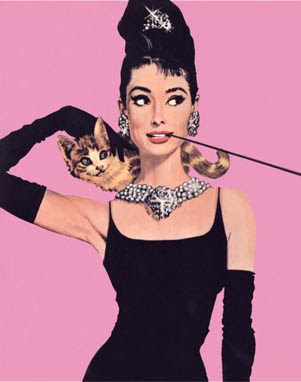lip top 10: awesome ladies of literature
 So far we’ve hit TV and film, so this fortnight it’s time to turn to awesome female characters in literature. I’ve tried to hit a few different genres here, so hopefully there’s something to please everyone. Jump into the comment box with any addition.
So far we’ve hit TV and film, so this fortnight it’s time to turn to awesome female characters in literature. I’ve tried to hit a few different genres here, so hopefully there’s something to please everyone. Jump into the comment box with any addition.
1. Holly Golightly (Breakfast at Tiffany’s, 1958)
‘Never love a wild thing. You can’t give your heart to a wild thing: the more you do, the stronger they get,’ says Holly in Truman Capote’s novella, and a “wild thing” is the perfect way to describe her. Flighty, irresponsible and of questionable morality (by 1950s standards), on the surface Holly may not be a role model, but it is these qualities that make you fall in love with her, because you soon realise that they are not character flaws, but the manifestation of the anxieties of someone who can’t figure out her place in the world.
2. Alexandra Cooper (The Alexandra Cooper Crime Series, 1996 – present)
I went through a huge crime fiction phase in high school which lasted about three years, but I lost interest when uni writing courses thrust literary greatness upon me. However, my enjoyment for this series, and its protagonist, is so enduring that five years out of school I still get really excited when a new book is to be released. Cooper is Sex Crimes prosecutor with the Manhattan District Attorney’s Office and throughout the course of the series has prosecuted high profile cases, been attacked by suspects and once saved the life of a detective. She’s also willing to put in the long hours and do whatever it takes to get the right result. I’d love to have just a smidgen of her tenacity.
3. Jean Brodie (The Prime of Miss Jean Brodie, 1961)
Jean Brodie was a teacher at a girl’s school in Edinburgh in the 1930s who sought to teach her students above and beyond the standard lessons. She wanted to teach them about love and travel (using personal experience), as well as areas of art and political schools of thought that were not a part of the curriculum. Although later in the novel she becomes quite manipulative and exploitative of some her students, I like to think that she started with good intentions.
4. Laura (American Gods, 2001)
The plot is rather complex, which in turn makes Laura’s awesomeness hard to explain, but she develops from a mopey, guilt-ridden ghost (she died in a car accident while giving the driver – not her husband – a blow job) to an animated corpse who saves a few lives, kills a few baddies and has some beautiful pearls of wisdom to share.
5. Coraline (Coraline, 2002)
Another Neil Gaiman character (the first being Laura), but a venture into Kid Lit. Coraline is a bored little girl who discovers a passage from her house into an alternate house which is basically a mirror image, except everyone is it much cooler. The problem is that her “other mother” wants to keep her in the alternate world forever, and kidnaps Coraline’s real parents for the purposes of blackmail. Coraline has to figure out to free her parents and trap the evil “other mother” in the other world. With a combination of smarts and agility she does so.
6. Lady Constance Chatterley (Lady Chatterley’s Lover, 1928)
Despite being bored to tears by this book, I couldn’t help but develop a melancholy admiration for Lady Chat. She went out and sought what she wasn’t receiving in her marriage – companionship and intimacy, turning her back on the mores and ignoring those who looked down on her.
7. Leslie Burke (Bridge to Terebithia, 1977)
This one is more about its nostalgic value for me. I remember reading this book in primary school and thinking how cool Leslie was. I was enraptured by her imagination, her intelligence and her courage. Basically, for those few weeks while we studied it, I wanted to be her.
8. Brod (Everything is Illuminated, 2002)
The word I would use to describe Brod is fascinating. Her story is one of the subplots in the novel, and we follow her from a rather mystical “birth” in a Jewish Ukrainian town, right through her adulthood. This term is terribly corny, but I suppose you could call her a deep thinker, which is what makes her so fascinating. Oh yeah, and she saved a young Jewish man from the Nazis. No biggie.
9. Hermione Granger (Harry Potter Series, 1997 – 2007)
This is arguably the most influential book series of my generation, and while there were many great female characters in them, Hermione is the greatest. From the first book she is brave and intelligent, but what makes her awesome is her growth over the course of the series. We watch her become more mature and more humble. Basically we watch her become the person we want on our team, not the person we’re trying to get away from.
10. Jean Louise ‘Scout’ Finch (To Kill a Mockingbird, 1960)
We see the story through her eyes. The novel can get pretty heavy, but the innocence of the little girl adds a genuineness that no adult character could. What I love about Scout is how black and white her world is, and while shades of grey begin to cloud it as the trial of the man that her father is defending progresses, she chooses to learn from what is going on around her, rather than shrugging it off like other children would do. I’m sure if there were more Scout Finch’s around there would be a lot less bullying happening in schools.

